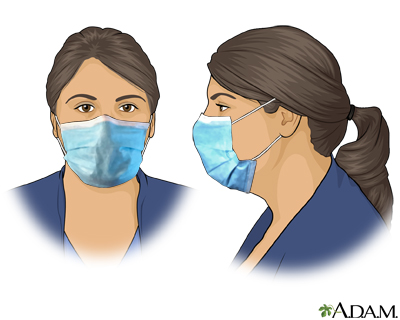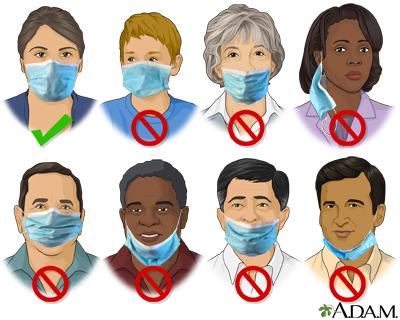Respiratory viruses and face masks
COVID-19 - face coverings; Coronavirus - face masks; Respiratory viruses - face coverings
In places where respiratory viruses are spreading, wearing a face mask in public helps protect other people from possible infection with viruses such as COVID-19 or the flu. Other people who wear masks help protect you from infection. Wearing a face mask may also protect you from infection.
Wearing face masks helps reduce the spray of respiratory droplets from the nose and mouth. Using face masks in public settings helps reduce the spread of respiratory viruses.
Images


I Would Like to Learn About:
Information
How Masks Help Protect People From Respiratory Viruses
Respiratory viruses spread most readily to people with close contact (about 6 feet [ft] or 2 meters [m]). When someone with the illness coughs, sneezes, talks, or raises their voice, respiratory droplets spray into the air. You and others can catch the illness if you breathe in these droplets, or if you touch these droplets and then touch your eye, nose, mouth, or face.
Wearing a face mask over your nose and mouth keeps droplets from spraying out into the air when you are speaking, coughing, or sneezing. Wearing a mask also helps keep you from touching your face.
You can choose to wear a mask and take other steps to help prevent respiratory viruses such as COVID-19 and the flu from spreading:
- When there are high rates of respiratory illness in your community
- If you or the people around you have a respiratory virus and are sick or recovering from the illness
- If you or those around you are at risk for severe illness from respiratory viruses
About Face Masks
When choosing a face mask, follow these recommendations:
- The most effective mask is the one that fits you comfortably and well that you are able to wear consistently.
- The face mask should fit snugly over your nose and mouth, against the sides of your face, and secured under your chin.
- Look for masks with a nose wire to help prevent gaps and prevent fogging if you wear glasses. Antifogging sprays may also help.
- While most all masks provide protection, some respirators (N95 and KN95 masks that meet certain standards) provide the best protection if worn properly.
- If you have a weakened immune system or are at high risk for severe illness, wear a mask or respirator that provides the highest level of protection (such as an N95 or KN95 mask).
- If you use cloth masks, they should be made of at least 2 layers of fabric that can be laundered in a washing machine and dryer. For extra protection, you can wear a cloth mask on top of a disposable surgical mask (creating a double mask). If you use a respirator (an N95 or KN95) mask, you should not double mask.
- If you have a beard, try to use a mask that fits around your beard or trim your beard to help with the fit. You can also use a mask fitter or wear a disposable mask under a cloth mask. Even if you have a beard that is not trimmed, wearing a mask will still help protect you.
- Make sure you can breathe comfortably through the mask.
- Do not use masks that have a valve or vent, which can allow virus particles to escape.
- In cold weather, scarves, ski masks, and balaclavas should be worn over masks. They cannot be used in place of masks, as most have a loose knit material or openings that allow air to pass through.
The Centers for Disease Control and Prevention (CDC) provides more detailed information on ways to increase mask protection.
Learn how to properly wear and care for a face mask:
- Wash your hands before placing the mask on your face so that it covers both your nose and mouth. Adjust the mask so that there are no gaps.
- Once you have the mask on, try not to touch the mask.
- If your mask becomes wet, you should change it.
- Once you return home, remove the mask by touching only the ties or ear loops. Wash your hands after removing the mask.
- Do not share masks or touch masks used by other people in your household.
Face masks should not be worn by:
- Children younger than age 2
- People with breathing problems
- Anyone who is unconscious or who is unable to remove the mask on their own without help
For some people, or in some situations, wearing a face mask may be difficult. Examples include:
- People with intellectual or developmental disabilities
- Younger children
- Being in a situation where the mask may get wet, such as at a pool or out in the rain
- When doing intensive activities, such as running, where a mask makes breathing difficult
- When wearing a mask may cause a safety hazard or increase the risk of heat-related illness
- When talking to people who are deaf or hard-of-hearing who rely on lipreading for communication
In these types of situations, staying at least 6 ft away (2 m) from others is particularly important. Being outside can also help. There may be other ways to adapt as well, for example, some face masks are made with a piece of clear plastic so the wearer's lips can be seen. You can also talk with your health care provider to discuss other ways to adapt to the situation.
References
Centers for Disease Control and Prevention website. The National Institute For Occupational Safety and Health (NIOSH). Personal protective equipment. www.cdc.gov/niosh/ppe/. Accessed April 29, 2025.
Centers for Disease Control and Prevention website. The National Institute For Occupational Safety and Health (NIOSH) Science Blog. N95 day 2016: proper use, filtration, and fit – the three-legged stool of respiratory protection. blogs.cdc.gov/niosh-science-blog/2016/09/06/n95-day-2016/. Updated September 6, 2016. Accessed April 29, 2025.
Centers for Disease Control and Prevention website. Respiratory illnesses: Masks and respiratory virus prevention. www.cdc.gov/respiratory-viruses/prevention/masks.html. Updated March 1, 2024. Accessed December 24, 2024.
BACK TO TOPReview Date: 1/1/2025
Reviewed By: Linda J. Vorvick, MD, Clinical Professor Emeritus, Department of Family Medicine, UW Medicine, School of Medicine, University of Washington, Seattle, WA. Also reviewed by David C. Dugdale, MD, Medical Director, Brenda Conaway, Editorial Director, and the A.D.A.M. Editorial team.

Health Content Provider
06/01/2025
|
A.D.A.M., Inc. is accredited by URAC, for Health Content Provider (www.urac.org). URAC's accreditation program is an independent audit to verify that A.D.A.M. follows rigorous standards of quality and accountability. A.D.A.M. is among the first to achieve this important distinction for online health information and services. Learn more about A.D.A.M.'s editorial policy, editorial process and privacy policy. A.D.A.M. is also a founding member of Hi-Ethics. This site complied with the HONcode standard for trustworthy health information from 1995 to 2022, after which HON (Health On the Net, a not-for-profit organization that promoted transparent and reliable health information online) was discontinued. |
The information provided herein should not be used during any medical emergency or for the diagnosis or treatment of any medical condition. A licensed medical professional should be consulted for diagnosis and treatment of any and all medical conditions. Links to other sites are provided for information only -- they do not constitute endorsements of those other sites. © 1997- 2025 A.D.A.M., a business unit of Ebix, Inc. Any duplication or distribution of the information contained herein is strictly prohibited.
